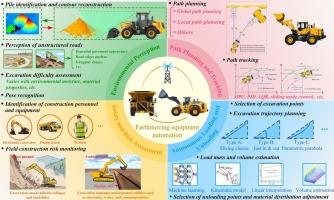土方设备自动化核心技术的进展与挑战
IF 11.5
1区 工程技术
Q1 CONSTRUCTION & BUILDING TECHNOLOGY
引用次数: 0
摘要
土方设备的自动化受到复杂介质、非结构化地形和高度可变的环境条件的相互作用的限制。尽管这一领域的研究已经持续了近30年,但真正的全自动系统仍未实现。本文研究了土方设备在典型的重复短周期装填作业中的自动化技术,并对30多年来的核心文献进行了系统的调查。关键技术分为四大类:环境感知、路径规划与跟踪、自主装卸和安全与风险评估。分析表明,目前的研究主要针对单个阶段或子系统的改进,而整个工作流的系统级优化仍然缺乏。此外,数据物理混合方法通过补偿物理模型的误差和提高数据驱动模型的泛化,在土方设备自动化应用中显示出强大的潜力。最后,总结了研究面临的主要挑战,并提出了未来的研究方向。本文章由计算机程序翻译,如有差异,请以英文原文为准。

Advancements and challenges in earthmoving equipment automation using core technologies
Earthmoving equipment automation is limited by interactions with complex media, unstructured terrain and highly variable environmental conditions. Although research in this field has continued for nearly thirty years, a truly fully autonomous system remains unrealized. This paper examines automation technologies for earthmoving equipment in typical repetitive short-cycle loading operations and presents a systematic survey of core literature spanning over thirty years. Key techniques are grouped into four categories, environmental perception, path planning and tracking, autonomous loading and unloading and safety and risk assessment. The analysis indicates that current research primarily addresses improvements to individual stages or subsystems while system level optimization of the entire workflow is still lacking. Moreover, data physics hybrid methods show strong potential in earthmoving equipment automation applications by compensating for errors in physical models and improving the generalization of data driven models. Finally, the major challenges are summarized and directions for future research are proposed.
求助全文
通过发布文献求助,成功后即可免费获取论文全文。
去求助
来源期刊

Automation in Construction
工程技术-工程:土木
CiteScore
19.20
自引率
16.50%
发文量
563
审稿时长
8.5 months
期刊介绍:
Automation in Construction is an international journal that focuses on publishing original research papers related to the use of Information Technologies in various aspects of the construction industry. The journal covers topics such as design, engineering, construction technologies, and the maintenance and management of constructed facilities.
The scope of Automation in Construction is extensive and covers all stages of the construction life cycle. This includes initial planning and design, construction of the facility, operation and maintenance, as well as the eventual dismantling and recycling of buildings and engineering structures.
 求助内容:
求助内容: 应助结果提醒方式:
应助结果提醒方式:


